DVDs and Literature (Star Wars-style)
Listening for the Story: Inside the DVD Commentary
Translating the Creative Process
By Bonnie Burton
For every emotional acting scene or magnificent digital effect there's a side story, and Revenge of the Sith DVD Commentary Producer Gary Leva is there to capture it for fans wanting to know more.
Leva not only offered his expertise to record and edit the audio commentary tracks for Revenge of the Sith (due to be released Nov. 1 on DVD)EDITOR'S NOTE: GIGGLE AND DROOL, GIGGLE AND DROOL, but for the entire Star Wars saga.
He has also produced a number of featurettes on previous Star Wars DVDs, such as Birth of a Lightsaber, Characters of Star Wars and The Legacy of Star Wars in the Star Wars Trilogy set, the Deleted Scenes Documentary on Episode I, and State of the Art: The Previsualization of Episode II documentary on Attack of the Clones. EDITOR'S NOTE: OH MY GOSH. HEAD HANGING IN SHAME. I STILL HAVEN'T WATCHED THE EXTRAS ON AOTC! (LEAVING THE COUNTRY NOW.....)
"This was my seventh commentary with George [Lucas], including all six Star Wars films and THX 1138," Leva says. "We have fun together and, since I've also produced documentaries for all the previous DVD sets, I know the ground we're covering pretty well by now. So I can ask intelligent questions and sort of guide him into areas I think would be interesting for fans. George has gotten increasingly skilled at doing commentaries. EDITOR'S NOTE: SO UNCLE G SPEAKS IN FULL SENTENCES NOW? It's been fun for me to work with him over the years and watch the progression."
For the Revenge of the Sith DVD, Leva interviewed not only writer and director George Lucas, but also Producer Rick McCallumEDITOR'S NOTE: WHO NEVER SHUTS UP, AND YET RARELY HAS ANYTHING TO SAY. (AIN'T IT ALWAYS THE CASE?), and Industrial Light & Magic Visual Effects Supervisors John Knoll and Roger Guyett, and Animation Director Rob Coleman.
To prepare for the commentary recording sessions Leva says he watches the film multiple times EDITOR'S NOTE: TOUGH GIG. so that his questions will help guide the participants with their train of thought.
"I don't do pre-interviews or anything like that," Leva says. "The participants say exactly what they want when they arrive. As we're going along, if I feel something they've said is unclear or perhaps too technical, I'll ask them to do another take, sometimes suggesting a more understandable way of approaching it. If they're running out of things to say, I might suggest areas of interest to discuss, things I think audiences and fans would be curious about. This is where it pays to be intimately familiar with the film."
For Leva, audio commentary among a group of two or more people together in a room is more exciting than one-on-one sessions. He edits together all the sessions as one cohesive track.
"I try to record commentaries with two or more together people whenever I can," Leva says. "For me, the interplay between participants makes it worth the unavoidable messiness of voices occasionally talking over each other. But scheduling makes it difficult. On this film, I was only able to record Rick McCallum and Roger Guyett together, and that was fun. Rick is hilarious -- he kept us in stitches the whole time. EDITOR'S NOTE: OF COURSE, THEN YOU HAVE TO EDIT OUT ALL THE PROFANITY.And that, balanced with Roger's erudite personality, made for a nice interplay."
The remainder of the audio commentators -- Lucas, Knoll and Coleman -- recorded their sessions with Leva individually -- often revealing rather technical information on everything from Yoda's distinct facial expressions to digital hidden gags such as the floating kitchen sink in the opening battle sequence.
"Rob Coleman has always been great at translating his creative process into layman terms," Leva says. "For some of the Visual Effects Supervisors, I think it's been a little more of a challenge. They live in a world of technology with its own language, even its own culture. But one of the things I try to bring out in the commentaries is that even though these guys work with these cutting-edge CGI tools, they're using these tools to do what filmmakers have always done -- tell stories."
Even with all the technical information and behind-the-scenes stories detailing the development of various scenes, Leva says he also likes to draw out the emotional side of the participants who tend to reveal their true appreciation for the saga as fans themselves.
"I want the commentaries to be as informative as possible -- to give fans a sense of the creative work that went into these films," Leva says. "But I also try to get past the minutiae and the 'how-to' stuff and uncover the way these guys feel about working on this particular Star Wars movie. In the case of some of the visual effects guys, they're finally getting to work on the film series they've loved since childhood -- maybe even the film series that made them want to be in the movie business in the first place. I always want to get to that emotion, that human element, beyond just the work itself." EDITOR'S NOTE: I NEVER CEASE TO BE REALLY MOVED (AND SURPRISED) BY THESE GUYS (USUALLY GUYS) AT THE TOP OF THEIR GAME IN THE FILM TECH ARENA, WHO STILL GIGGLE AND DROOL LIKE WE LOWLY DWEEBS-IN-THE-TRENCHES OUT OF A EVER-VIBRANT PASSION FOR THE STAR WARS SAGA. AS FANS.
Many of those very personal sentiments regarding the last Star Wars film came out in the commentary as Leva made certain that the participants, especially Lucas, waxed nostalgic over the many years of hard work that went into creating such an epic saga.
"On Episode III, I asked people to give me a look back at their experience on this, the final Star Wars feature," Leva says. "In the case of George, it was fun to hear his perspective on this mammoth adventure which basically took over his life for close to 30 years. George had no idea when he made A New Hope in the mid-'70s that this would happen. He was just satisfying his own desire to update the adventure films he loved as a kid to a galaxy far, far away using current technology. I think continuing to serve that childlike sense of wonder in the subsequent films has been his greatest challenge."
Untold Stories
While the structure of gathering the best commentaries may be casual, Leva actively listens during their discussions for topics and themes from his participants and guides the direction of the information from there.
"The way it works is, George and I just sit in the theater together and we watch the film and he just talks about what interests him," Leva explains. "I'm always listening carefully, so if something's unclear, I'll get him to start a section over. If he runs dry, I'll ask questions about things that interest me. I know George's history well -- not just in terms of Star Wars -- but the films that preceded Star Wars and even further back than that. So I can tie in his history to the film on screen."
"For example, in Episode I, there's a sequence where young Anakin has his Podracer broken down and basically up on blocks in his yard," Leva continues. "His friends are kidding him about racing that heap. Now I know that when George was a teenager, he was always building his own hot rods and racing them around his home town of Modesto. So I guessed that this history was the basis for that scene -- and I asked him to talk about it. Sure enough, he did a very fun little story about it. That's one way in which knowing your subject can be very valuable to an audio commentary producer."
One of Leva's biggest challenges producing the audio commentary this time around had less to do with getting the most out of the participants, but more with agonizing task of determining which quotes to cut from the final track during the editing process.
"There is often as much stuff on the cutting room floor as there is in the final commentary," Leva confesses. "Remember, my commentaries for the Star Wars discs include 5 or 6 people cut into a single track, so we're always having to make difficult choices. It's often an embarrassment of riches, with great stories going by the wayside. [Sound Designer] Ben Burtt, in particular, has given me some fascinating stories over the years that were too long or too tangential to include. With his encyclopedic knowledge of film history, he could fill a track of his own very easily."
In some cases, editing the comments had less to do with fitting it in the allotted time, and more to do with keeping the film PG-13.
"Rick has funny, irreverent, sometimes unrepeatable comments, that keep us all laughing," EDITOR'S NOTE: DID I NOT SAY THIS? (SOME CALL IT IRREVERANT, OTHERS MIGHT CALL IT CRUDE. SECOND-COUSIN RICK....BY MARRIAGE...DOESN'T HAVE A WHOLE LOT BESIDES 'IRREVERENCE' TO OFFER, HUH?) Leva smiles. "Those end up on the cutting room floor, I'm afraid.EDITOR'S NOTE: LESS RICK IS USUALLY MORE. After all, these movies are made for all ages, including young children!"
In previous audio commentary tracks for the Star Wars trilogy DVDs, Lucas, Burtt, director Irvin Kershner, actress Carrie Fisher, and Industrial Light & Magic's Dennis Muren offered their thoughts, stories and trivia to the film experience. Yet it's one particular chatty protocol droid that Leva has his sights set on interviewing if the opportunity were to ever arise.
"I'd love to include Anthony Daniels in an audio commentary," Leva says. "He's the only actor to span all six films, and he's a delightfully funny, talented performer. I think fans would appreciate hearing his perspective." EDITOR'S NOTE: SO WHY NOT INCLUDE MR. D? (EVERYTHING SOUNDS BETTER IN BRIT, DOESN'T IT?)
With the evolution of DVD interactive menus, as well as the need to include value-added material such as making-of documentaries, behind-the-scenes interviews and music soundtrack videos, it's no surprise that audio commentaries are just in demand by fans wanting to know more about their favorite films. But Leva stresses that there's more to commentaries than a group of people sitting in a room chatting about how they miss the catering, or which actor was the most difficult to cast.
"At their best, audio commentaries can be like a day in film school with a group of accomplished film artists," Leva explains. "They bring you into the creative process and demystify the way filmmakers do their jobs. My favorite commentaries are always focused on the ways in which various film artists apply their skills to the cinematic storytelling process. I hope we've achieved that on this film." EDITOR'S NOTE: AND THEN THERE'S THE COMMENTARY ON THE "DIE HARD" FILMS, WHERE I SWEAR THE DIRECTOR WAS STONED. (AND NOT IN ANY KIND OF AMUSING WAY).
"Working with George again, building on the experience of doing this six times before, has been my biggest reward," Leva adds. "There's nothing like working with people you like and respect. Producing documentaries and featurettes, and being the audio commentary producer for the Star Wars series has been an experience -- and a privilege -- I will cherish."
Excerpts
George Lucas, Writer/Director EDITOR'S NOTE: WHO?
On R2-D2's action scenes:
"This sequence in the elevator is to give Artoo a little space and give him a chance to be in the movie. I love Artoo and I wanted to get a chance to have some fun with him at the very beginning of the movie when I still had time to do that. And again build up the relationship between Anakin and Obi-Wan. Because I wanted to make sure people thought they were very comfortable with each other, friendly with each other and had gotten over the petulant rivalry that existed in the last movie.
"There was a lot of discussion to pull this sequence out of the movie, but it's one of my favorite sequences and I refused to let it go and I like Artoo. From my point of view I think this is for Artoo... it's the funniest sequence, for Artoo fans, which I am one of the biggest ones."
On General Grievous:
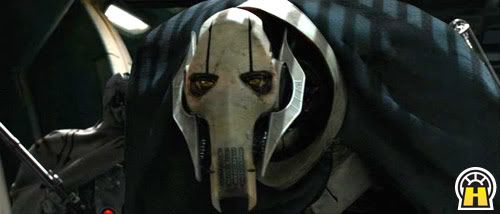
"I worked to build more character with him [Matthew Wood]. When we were recording, I happened to have bronchitis and so we did a few takes where I just sat there and coughed. And that way we sort of built this more interesting character. To give you a little sense of the fact that he's in a robot suit for a reason. He's obviously damaged goods. But I didn't want it to be like Darth Vader. I wanted it to be slightly different. He didn't have that artificial breathing sound.
"One of the big issues behind Grievous was that I didn't want to have a big, powerful villain. I wanted a cunning, almost cowardly villain, who isn't super-strong or super-powerful, but at the same time, is a good fighter but I didn't want to get someone who's bigger, stronger and more powerful than the other villains we've had. Going to the next level, I wanted him to be slightly more like the Emperor, slightly more of the sleazy behind-the-scenes kind of guy. That's why I set up the fact that he always runs at the end of every fight; he always gets away."
On Yoda's particular gesture:
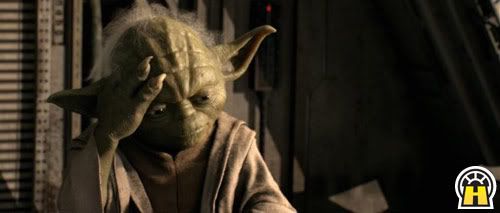
"The lead samurai in that picture [in The Seven Samurai] has to shave his head to pretend he's a monk and he's constantly sort of rubbing his newly-shaved head and that's where that little affectation for Yoda came from."
On Politics:
"This was written a long time ago. It was based on history. All of Star Wars is reasonably political; it's just that most people never noticed it until this episode was put into the puzzle.
Sometimes the politics are confused and muddled the way people see it, which is the way most people see politics. But it's because they're confused and muddled, people don't want anything to do with it. Of course, when they don't want anything to do with it, that's why they end up turning to somebody to take over and clean it up.
On Bail Organa's speeder:
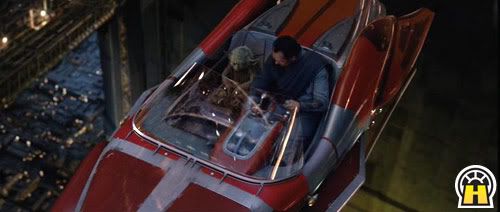
"The car that Bail Organa drives here is based on a Tucker, if you were to look at it very closely. Another reference to one of my movies. I guess we should have put a THX 1138 license plate on it, but we forgot."
Rick McCallum, Producer EDITOR'S NOTE: COFFEE, MR. LUCAS?
On the elevator/R2-D2 scenes:
"Well I have to be honest, I always felt that the elevator sequence dragged. The only way I thought you could speed it up and get them to Palpatine's office was to eliminate all the Artoo stuff and God was I wrong! People really reacted. And that's why I'm the producer. I live in the dark side all the time." EDITOR'S NOTE: OR JUST IN THE DARK.
On the Dooku battle:

"Now here's where I must say, this is from the dark side, I really felt that we were going to have a hard time with the censors, first with the hands and this is just brilliant when his [Dooku's] head goes off. But I thought he [George] had done that just to wind me up because we had started talking about the censors and I was very happy he kept that in. It's a great little moment."
On working with Lucas:
"It's interesting. I take the same road home every night George does. And I come to work on the same road. But my God, he sees things so... I can't even imagine. He starts the day off -- this is what I really love about him -- he comes in and there's always this little grin on his face. And he always starts off the same thing -- 'What if we did this?' and you can tell he's been thinking about it all night. He's gotten really excited and he rushes in and then you're just confronted by these new ideas every day that evolve for two or three years." EDITOR'S NOTE: AND THEN LUCAS TURNS TO MCCALLUM AND USES VERY SMALL WORDS, AND SOMETIMES SECOND-COUSIN RICK CAN KEEP UP.
Roger Guyett, Visual Effects Supervisor
On the Kashyyyk battle:
"I think the thing that excited me most was just the idea of having this D-Day landing going on there and the combination of real and CG Wookiees was just a killer scene to get to work on. And I think it worked in the end. Shots where there's so much going on, it's just an incredible amount of work that goes into just putting these scenes together. But we did so much of the work in CG in terms of the water just because of the level of interaction that you needed for the crashes."
On Mustafar:
"I always felt like you wanted to convey the feeling that if you really happened to stand outside that you'd almost instantly combust, that some ember would blow across and set you on fire. EDITOR'S NOTE: WELL I KNOW PEOPLE IN HOUSTON UNDERSTOOD THAT. BECAUSE WE DEAL WITH THAT SORT OF FEELING FOR MOST OF THE MONTH OF AUGUST HERE.
John Knoll, Visual Effects Supervisor
On the opening space battle:
"Now one of the things that make this [opening] space battle different than the other Star Wars pictures is that we're saying that this is not in space exactly, but the upper atmosphere of Coruscant, which gives us excuses to do things like drag, you'll see there's smoky trails behind burning ships. There's bits of atmosphere hanging in smoke."
On General Grievous: "The reason Grievous is coughing in all these shots is explained in a Clone Wars cartoon that depicts the action that takes place right before Episode III starts. If I remember right, he gets into a confrontation with Mace Windu who does a Force choke to him that results in him coughing throughout the whole first part of the picture."
On Yoda's chair movement:
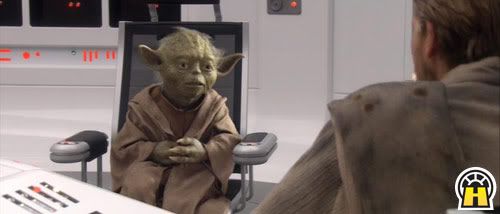
"I never figured out how Yoda is supposed to be moving his chair. We talked about it a bit at the time, and George just said, 'He's using the Force.'" EDITOR'S NOTE: GIGGLE. IN A PINCH..... (YODA DOES DISHES THAT WAY TOO?)
Rob Coleman, Animation Director
On the opening space battle: "George felt very strongly that we needed to have choreography on these planes. He reminded us that he was really happy with the work that ILM had done on Pearl Harbor. So we specifically went after Scott Benza and Glen McIntosh who were my lead animators for this sequence and they did a great job. They had about 6 or 7 animators working with them."
On General Grievous:
"Grievous to us was always this sickly character. And so this coughing that he has and this hunched movement that he has, for George at least, referred to sort of how this creature inside this droid wasn't fully working, the systems hadn't been perfected yet."
On the Coruscant ballet:
"I remember being on set in Sydney when George and Rick came in with a very sort of devilish smile on each of their faces. And they told me that they had added what they called 'Squid Lake' into the movie. Quite honestly, I thought he was joking and didn't really take him seriously until I started to see artwork coming from Skywalker Ranch while we were still shooting the movie. It took a number of months for us to come to the design of what this would look like -- zero gravity balls of water floating in a theater space. The art directors designed the ballet dancers with their long streamers."
On the Utapau clone troopers:
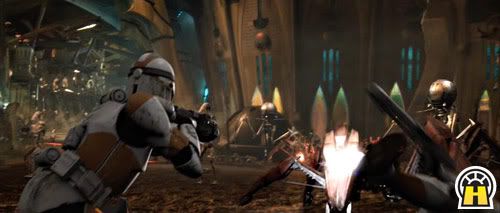
"We've got a lot of motion capture here. This time however what we did was put a performer who is an actual ex-Navy SEAL in the suit and we got much more realistic movement. George had sort of told me after Episode II that he could tell it was a bunch of animators running around as clones last time, and he wanted more realistic motion, and so our attempt to deal with that was to actually have someone who had military training." EDITOR'S NOTE: PLUS, ANIMATORS CAN'T SUSTAIN MOVEMENT FOR VERY LONG. I IMAGINE YOU COULD DO MUCH LONGER TAKES WITH AN EX-SEAL. (TEE HEE). AND THINK OF THE SAVINGS ON DONUTS AND COFFEE!
Inside the DVD Documentaries
Sith in 60 Seconds
by Pete Vilmur
"It truly is mind-boggling how many people, how many thousands of hours it takes to make just one sequence -- a sequence that's over virtually within a minute." -- Episode III Producer Rick McCallum EDITOR'S NOTE: THEN AGAIN, SO MUCH BOGGLES YOUR MIND, RICK, DOESN'T IT?
As narrator of the long-form documentary found on the Episode III DVD release, producer McCallum guides viewers through the expansive pool of talent and artistry responsible for bringing a mere 49 seconds of Revenge of the Sith to the screen.
Within a Minute: The Making of Episode III takes a far more intimate approach than previous Star Wars documentaries, seeking to reveal the vast scope of the film's production within the microcosm of a single scene.
Because one scene would be dissected for a study of its parts, finding the right one was essential.
Within a Minute's creators found that the best way to expose the vital organs of Revenge of the Sith was to go straight for the heart of the saga -- the tragic duel between Anakin and Obi-Wan. No other scene so well defined the spirit of Revenge of the Sith, or the massive scale of talent required to bring the saga's final chapter to life.
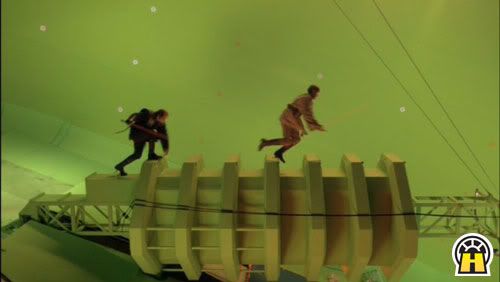
The opening titles of the documentary reveal the staggering figures needed to complete the scene: 26 shots -- 1,185 frames -- 910 artists -- 70,441 man hours. Capturing the hundreds of artists and hours became the task of Lucasfilm's tireless team of documentarians, headed by Within a Minute director Tippy Bushkin. Lead editor on the project was Duncan Sinclair.
Unlike the previous documentaries for Episodes I and II, Within a Minute was all shot and cut in-house. This allowed Bushkin and Sinclair to work closely with Lucas, who ultimately came up with the doc's "scene anatomy" concept.
"What he wanted to do," explains Bushkin, "was really give you an in-depth view and intimate understanding of what it takes to do even a small portion of the film. He also really wanted to honor the people that have been on the journey with him through all three films."
Working with less than 60 seconds of Sith, the search was on to find a scene that effectively represented the film as a whole. Pretty quickly, the duel sequence became the clear choice.
"That's such a climactic sequence, you know, the juice of the film," says Bushkin. "We were looking for something that incorporated stunt work with the saber fighting, something which showed the course of the costumes being worn, something that had a lot of interesting elements in terms of ILM, and all of the different aspects that go into creating a shot with visual effects and CG work."
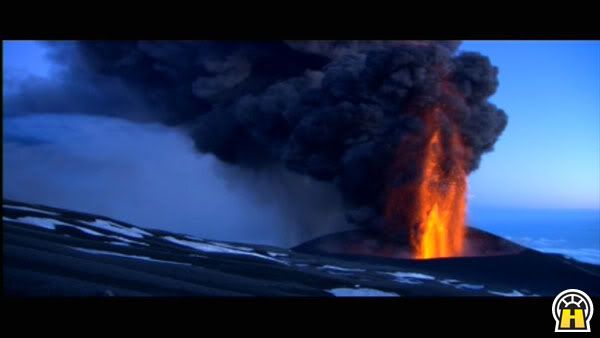
MT. ETNA (STUDIED FOR VOLCANO RESEARCH)
Sinclair remembers anticipating the Mustafar choice during the pre-production phase.
"Right back in the early days, we were thinking that the Mustafar fight could be one of the scenes that we might want to concentrate more on, so back in the Art Department I made sure that we covered as much Mustafar material as we could."
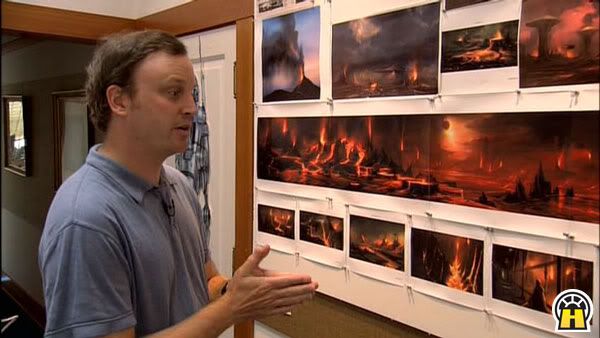
The idea to examine a single scene was actually late-breaking, and wasn't fully green-lighted until after all the raw documentary footage had already been shot. Fortunately, the tenacious doc crew had been very effective in collecting hundreds of hours of footage during production, so was able to take the restrictive "60-second scene" concept in stride.
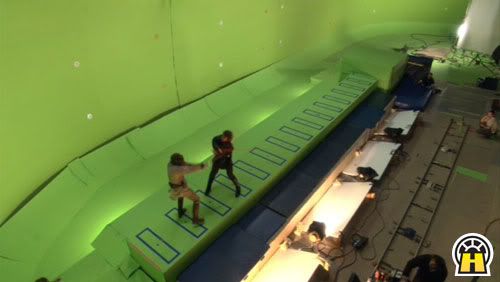
"Tippy has always been very good at covering all her bases," says Sinclair, "so it wasn't like she restricted herself to a particular idea of the where the documentary was going. When you're covering something this huge, you never know where it's going to take you. You have to give up your ideas of what life you're going to show, and show what the movie wants you to show."
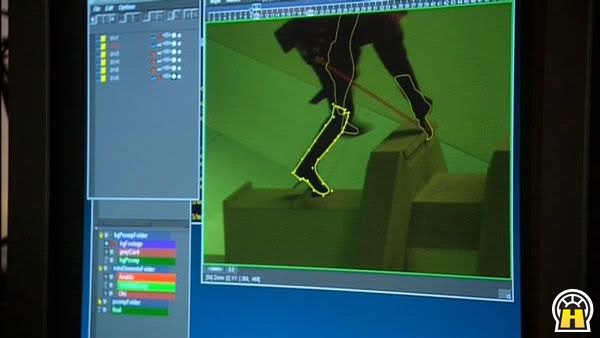
A rotoscope artist meticulously traces Anakin's foot to isolate him from the background footage.
Guiding the Way
The structure of the 80-minute documentary is roughly chronological, opening with a shot of Lucas penning the script. From there, it moves into the various phases of production for the Mustafar sequence, arriving at Lucas' directorial role somewhere in the middle. An unconventional choice, since one might guess Lucas' role as director would head up the hierarchy.
"I think that if he were not somebody who was also the writer," explains Bushkin, "and also acts as a producer in terms of going into every single aspect of what's being done on his film, then as the director you would introduce him up front and talk about his vision for the movie. But because he's such an integral part of every single aspect of the production, he's bigger than a director." EDITOR'S NOTE: HE'S A DWEEB GOD, REALLY.
With scores of cast and crew to cover, a single voice was needed to steer the viewer through the twists and turns of a major movie production. Fortunately, the doc crew found the perfect guide in producer Rick McCallum. EDITOR'S NOTE: SIGH.... I GUESS IT GAVE SECOND-COUSIN...BY MARRIAGE...RICK SOMETHING TO DO WHILE ALL THE REAL TALENT WAS WORKING ON REAL STUFF. (AND KEPT HIM OUT OF THEIR HAIR?)
"George had mentioned to Tippy and me earlier on that he didn't understand why documentaries these days traditionally avoid using a narrator," says Sinclair. "So it came back to us at some point that we should have a narrator giving us a through-line of the story and it was pretty obvious that Rick would be the best one to do that."
With McCallum at the wheel, viewers are taken on a journey through the pre-production phase of script writing and concept drawing, through the actual production phase on set with the actors and stuntmen, and finally through the postproduction phase which delivers the visual effects, sound effects, and score. Nestled in between these often highly visible aspects of movie making are peeks into the hidden corners of a living, breathing production -- this includes the office staffs, payroll departments, and food caterers, to name just a few. The unwavering exposition of all of Sith's parts is at the heart of Within a Minute.

ANY OTHER VOLUNTEERS TO DRESS YOUNG OBI-WAN? (SNICKER)
Both Bushkin and Sinclair admit to taking away strong impressions of Lucas, with whom they worked very closely throughout the Sith production.
"He's extraordinarily competent, he's extraordinarily confident, he's calm, cool, and collected on the set," explains Bushkin. "I mean, he is revered that way as a director. He creates an energy that is so powerful and I think successful in terms of keeping the crew focused and absolutely being their best in the moment. There's no fear --- it's all very relaxed. Everyone's doing their job and if there's a problem, George handles it beautifully." EDITOR'S NOTE: WE DO LOVE OUR UNCLE GEORGE!
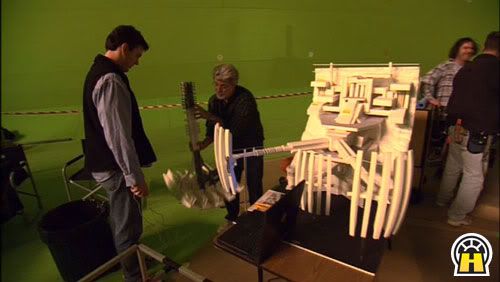
Sinclair shares equal respect for the Star Wars director.
"There's a lot I've learned about George, especially in the Art Department stage where you see how knowledgeable he is about history, art, art history, and politics. There were a lot of fascinating discussions in the Art Department because that's where all the ideas were being generated, and to me that's the really interesting thing to see and hear. He's more than just a filmmaker; he's a storyteller, and a man who knows a lot of things beyond filmmaking."

Visual Effects Supervisors John Knoll and Roger Guyett inspect the Mustafar landscape model under construction at ILM.
Bonus Documentaries
In addition to Within a Minute, disc two of the Episode III DVD also contains two shorter documentaries -- It's All For Real: Stunts of Episode III and The Chosen One, a revealing look at the re-emergence of Darth Vader in Revenge of the Sith. Both were directed by Bushkin.
For The Chosen One Bushkin was thrilled to capture some rare insights into the iconic Vader character, conveyed through Lucas' direction of Hayden Christensen.
"I think George had moments where he earnestly wanted to work with Hayden and get a little more intimate on the set to help him really understand where he was coming from at that moment. When you've got actors working on green screen, they don't have reference to what's going on around them. I think George does have those intimate moments with his actors, and I think we got some of those moments with Hayden." EDITOR'S NOTE: TOO MUCH TIME SPENT WITH ODDBOB...I WENT TO AN OOKIE/BAD PLACE THERE FOR A SEC. (FORGIVE ME, UNCLE GEORGE!)
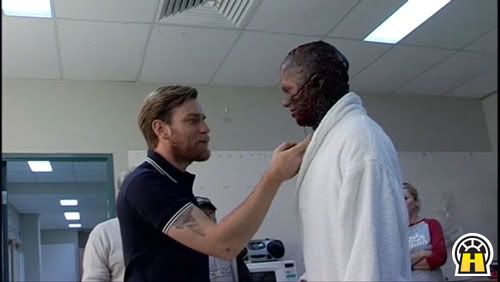
SPEAKING OF OOKIE/BUT SEXY/BUT OOKIE........
In It's All For Real, Bushkin focused attention on prequel Stunt Coordinator and Swordmaster Nick Gillard.
"What Nick Gillard does with these films is so huge that we really needed to honor his work in the context of this last film -- especially when you look at the duel, which was extensive. I think it's important for people to understand that he wasn't just choreographing and accomplishing that duel with George and the actors; he was also dealing with a lot of other stunt work that had to be done. The whole beginning of the film, with the opening battle scenes and afterwards where you've got Ian, Hayden and Ewan going through the ship, those were all stunts that were done, some by the actors and some by the stunt crew. So it's also honoring the stuntmen and their work."

The documentary features comparisons of the various edits of the film.
Bushkin and Sinclair also find themselves in agreement on the tireless perseverance of the Lucasfilm doc crew, and the unmatched dynamic they all enjoyed while covering Sith for the DVD bonus features.
"We had a fantastic team of people helping us out," says Sinclair, "and I'm not the only editor -- there were five or six of us. That's actually one of the things I like about the documentary -- there are different flavors within it, partly because there were different editors which sort of broke up the tonality of the whole piece. It was very organic."
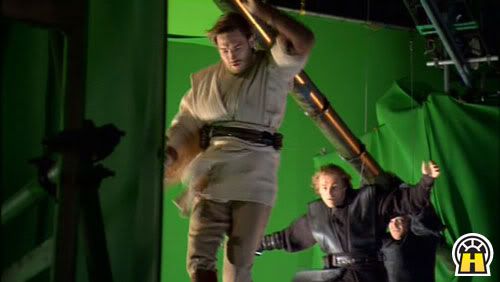
In addition to Bushkin and Sinclair, Lucasfilm's core doc crew included Kyle Ruddick, Amy Do, Michael Klima, Duane Trow, Mousy McCallum, and Jason Watkins.
"From my perspective in doing this," adds Bushkin, "we came together as a team in the documentary department in an extraordinary way. What was interesting was that different people had different interests in different aspects of filmmaking, or were very familiar with certain material. Every single one of them rose to the occasion and ended up cutting several segments, and we were all thrilled. I think that what we experienced on our documentary in the editing is very similar to what George feels when he's making his films. Everybody puts their ego aside and says, how are we going to do this film the best possible way? I thought it was really cool."
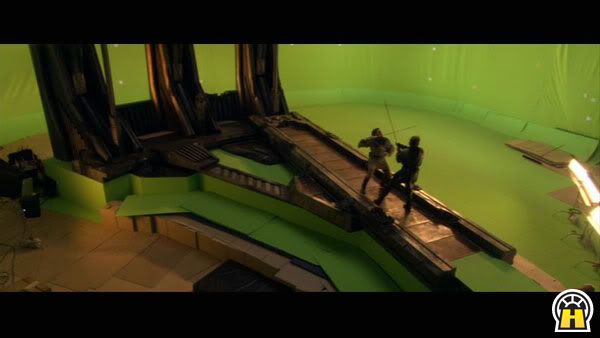
The actual plate photography of the scene, shot on Stage 3 at Fox Studios, Australia.
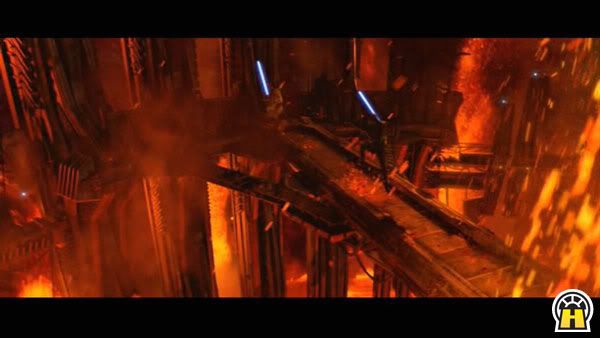
The same shot, layered in with ILM's amazing visual effects.
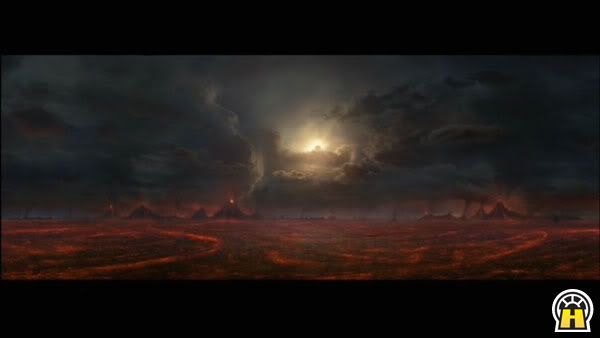
The animated backdrop matte painting for Mustafar.
Nitpickers's Guide To Star WarsWith the new book, The Unauthorized Nitpicker’s Guide to the SW Saga, you can check your Star Wars fandom knowledge against the ultimate list.
From a book press release:
Science Fiction Fans Extraordinaire T A Chafin and Polly Luttrull Release the Ultimate "Blooper and Fun Fact" Guide to the SW SagaBaton Rouge, LA, September 22, 2005:
No matter how many times George Lucas has tinkered with his six Star Wars movies, he still hasn’t fixed all of the mistakes, including the Stormtrooper who bangs his head on an overhanging door.
As fans anticipate the release of the final film in the first trilogy on DVD this holiday season, Star Wars aficionados T A Chafin and Polly Luttrull are also releasing “The Unauthorized Nitpicker’s Guide to the SW Saga.”
The book is filled with hundreds of gaffes, goofs, fun facts and oddities, carefully organized by film and by release.
Chafin and Luttrull painstakingly reviewed each edition of the film so regardless of which version you own you can read along and watch as Darth Maul’s lightsaber mysteriously switches hands or Princess Leia’s birthmark inexplicably disappears.
The 175-page book, retailing for $15.00, took Chafin and Luttrull over a decade to annotate and compile. EDITOR'S NOTE: STILL THINKING THEY HAVE TOO MUCH TIME ON THEIR HANDS....
This is an outgrowth of their traveling road show, where they have talked up the films, both the positive and the goofy, at science fiction conventions around America.
"We started this book even before George Lucas began writing ‘Episode 1: The Phantom Menace,’” says Chafin, a resident of Louisiana. “We hope it’s well received.”
Luttrull spends her days at as museum curator and brings her historian's eye to the project. “Polly has a far broader knowledge of the Star Wars Universe than I do,“ confided Chafin, “I tend to focus more specifically on the movies, television, and the animated series, whereas she has read just about every Star Wars book that’s ever been written. EDITOR'S NOTE: DWEEBCHICK AFTER MY OWN HEART! Both of these areas were invaluable in putting this book together. It makes us a pretty effective team.”
While researching this book, the pair watched the various releases of the movies more than 800 times and claim to find something new with every viewing. EDITOR'S NOTE: 800?! I'M IMPRESSED. FRIGHTENED AND IMPRESSED.
The book provides time references for every version and format of the movies. Whether watching a VHS tape, laser disc, or DVD, “The Special Edition” or the original edit, you will be able to follow along.
The book also tells about incidents that take place in versions of the movie you may not own.
“No single recording of any one of the movies shows everything we found,” revealed Chafin. “You have to watch all of the movies in every release in order to see what we’ve uncovered. Or, you can read about them in our book.”
The book is available from Amazon.
Autographed copies can be purchased directly from the authors through www.swbloopers.com or you can email them directly at swbloopers@yahoo.com. EDITOR'S NOTE: I MAKE FUN OF THEM, AND NOW I AM TEMPTED. BACKING AWAY FROM THE KEYBOARD.....
Inside Star Wars: Where Science Meets Imagination Book
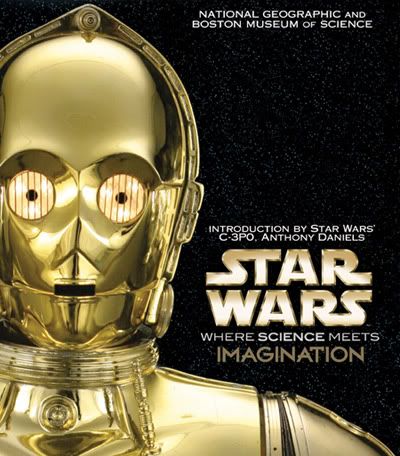
When will we all have our own R2 units to save us from sticky situations? EDITOR'S NOTE: YES, WHEN WHEN !!??? Is there a practical use for a droid who knows etiquette? Will we soon be commuting from home to work in our landspeeders? Is hyperspace even possible?
Fans can now get scientific insight into these questions and more with Star Wars: Where Science Meets Imagination, National Geographic's companion book to the Boston Museum of Science exhibition. EDITOR'S NOTE: THERE WAS ACTUALLY A VERY GOOD 3 OR 4-PART SERIES ON DISCOVERY CHANNEL THIS SUMMER ON THE SAME TOPIC. PARSING THE REAL SCIENCE FROM THE SCI-FI. (HOSTED BY C-3PO, NATCH).
The book assembles a team of some of the world's most creative scientists and engineers to consider how the culture of Star Wars has inspired cutting-edge science, and what the limits are of tomorrow's technology. Scientists, robotics specialists, and key members of Industrial Light & Magic write about the technology and inspiration behind real-life droids, the future of space travel and more.
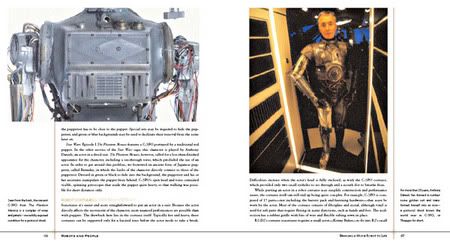
Appearing in all six Star Wars films as the protocol droid with plenty to say, as well as the only human to be inducted into the Robotics Hall of Fame, actor Anthony Daniels (C-3PO) was aptly asked to write the forward to this provocative book. In his essay "See-Threepio and I," Daniels chats about how it never occurred to him that he "should personally make a living inside a box, wheeling around and waving a sink plunger but never using the stairs" as the man inside the C-3PO suit. Daniels goes on to describe his first as well as his last experiences in that memorable -- and sometimes unforgiving -- suit.
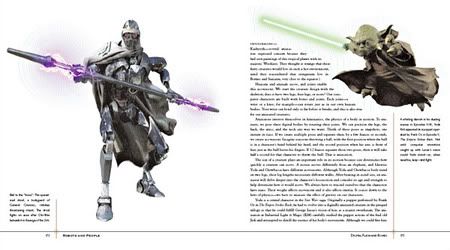
His essay not only gives fans insight into the challenges for an actor to act within costuming confines, but also on the astounding feat it must have been to make every single fan believe such a human-like droid could exist at all. In his essay, Daniels also reveals his feelings about a deleted scene from Episode II where he and Padmé have a brief chat about C-3PO's lack of coverings, which in turn shows a rather sad side of the protocol droid.
"Unable to sleep, the young woman discovers the droid quietly sitting, alone, in the garage on Tatooine -- his wiring and motors still exposed, as on the first day of his creation," Daniels writes. "She asks if he is happy there, and the sensitive machine replies that is not un-happy; it's just, well, to be like that... Like what? Naked! If you'll pardon the expression. It simply wasn't protocol. And for a machine whose primary function is etiquette, to be unclothed in the world... well! Exquisite, enduring humiliation. I found it one of the most tender moments in all six films, a chance for the audience to glimpse whatever area of electromechanics might harbor Threepio's soul." EDITOR'S NOTE: IN THE EU, THERE ARE SEVERAL INSTANCES WHERE 3PO TEETERS ON THE BRINK OF TRUE SENTIENCE. ESPECIALLY DURING THE NEW JEDI ORDER, WHEN FACED WITH A SPECIES....THE YUUZHAN VONG....WHO DESTROY DROIDS.
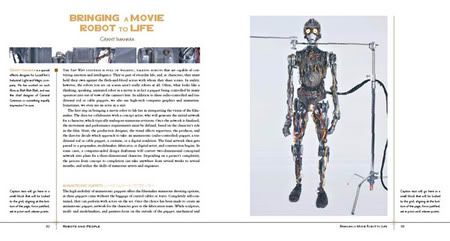
Various topics in the book mirror similar topics in the touring museum exhibit of the same name, including vehicles and spaceships of the future, robots and their interaction with humans, digital characters who come to life and more.
Among the various scientists and professors asked to confess their admiration and awe of the droids who populated a galaxy far, far away are Cynthia Breazeal, Associate Professor of Media Arts and Sciences, and Director of the Media Lab Robotic Life Group at the Massachusetts Institute of Technology (MIT).
The professor writes in her essay "Human-Robot Relationships" about being inspired by C-3PO and R2-D2 to research human-robot interactions and later to design the world's most-socially advanced robot -- Leonardo.
While in the essay "Space, Time, and Star Wars, Lawrence M. Krauss, Ambrose Swasey Professor of Physics as Professor of Astronomy and Director of the Center for Education and Research in Cosmology and Astrophysics at Case Western Reserve University, covers other areas of Star Wars science such as the physics of space travel and reveals his stance on why humans will never experience roundtrip voyages to distant stars. EDITOR'S NOTE: NEVER? (I REFUSE TO ACCEPT WORDS LIKE 'NEVER')
The complete list of contributors in the book include:
Ed Rodley -- Boston Museum of ScienceLawrence
M. Krauss -- Director of the Center for Education and Research in Cosmology and Astrophysics at Case Western Reserve University
Marc G. Millis -- Propulsion Physicist and Founding Architect at the Interstellar Flight Foundation
Sam Gurol -- Director of Maglev Systems, General Atomics
Hiroshi Nakashima -- Deputy Director General, Maglev Systems, General Atomics
Alex Jaeger -- Industrial Designer and Visual Effects Art Director, Industrial Light & Magic
Rodney Brooks -- Co-founder and Chief Technical Officer of iRobot Corp., Director, Computer Science and Artificial Intelligence Laboratory, MIT
Richard M. Satava, MD, FACS -- Professor of Surgery, University of Washington Medical Center, and Program Manager, Defense Advanced Research Projects Agency (DARPA)
Cynthia Breazeal -- Director, Media Lab Robotic Life Group, MIT
Dean Kamen -- Inventor of the Segway HT
Grant Imahara -- Animatronics Engineer and Model Maker, Industrial Light & Magic
Rob Coleman -- Animation Director, Industrial Light & Magic
Illah R. Nourbakhsh -- Robotics Group Leader at NASA/Ames Research Center, and Associate Professor of Robotics, Carnegie Mellon University.
To read more about Star Wars: Where Science Meets Imagination exhibit,
which opens at the Boston Museum of Science on Oct. 27, click here http://www.mos.org/doc/1293
Setting the Star Wars Stage: John Knoll's 365 Days
Expanding Visions
Over the years, fans have had access to the concepts and designs that inspired the Star Wars universe through a series of quality art books devoted to each film in the saga. But the practical end result of some of those designs -- the sets and locales that were built from them -- have seldom been explored at any length, save for the few fleeting moments they flicker across the movie screen.
John Knoll, Visual Effects Supervisor for Star Wars Episodes I, II, and III, grants unprecedented access to the closed sets of the Star Wars saga in his book Creating the Worlds of Star Wars: 365 Days, now available from Abrams.
As the latest in Abrams' popular 365 Days series of books, Knoll's chronicling of the saga through the use of hundreds of never-before-seen images and text is a testament to the set designers and effects supervisors who bring the Star Wars universe to life.
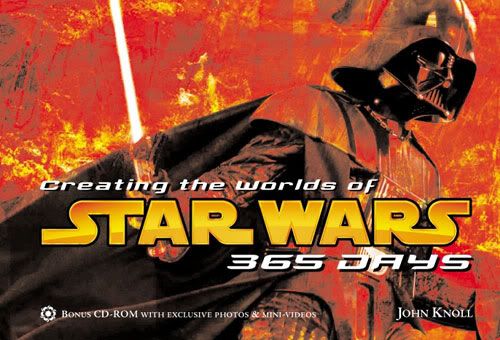
Counting in at 738 pages (with over three times that in images), 365 Days offers more than a fresh take on the backstage tactics that define the Star Wars "look" -- it demonstrates the methodology artists use to create realistic settings for the actors to inhabit. This includes decisions on how far to build out a set before allowing special effects to take over -- matte paintings and models in the case of the original trilogy, with a few digital extensions and additions for the prequels.
According to Knoll, the project actually sprung from a need to practically record the conditions on set during the making of Episode II. "I brought a panoramic camera setup with me and would shoot at least one or two panoramas for every set that we were on," explains Knoll. "I originally did them because they were kind of fun and were a good reference for us -- the panorama captured 360 degrees, so you'd have a record of all the lighting that was used for a scene. It captured [the set] in a way that individual stills couldn't."
The 360-degree images became the basis of Knollvision when it debuted publicly as a starwars.com Hyperspace feature. The innovative panoramic shots when paired with Quicktime VR software allow a viewer to examine a set 360 degrees around, and up and down.
While shooting Episode III on the set with a slightly enhanced version of this camera, Knoll ran into Jonathan Rinzler (LucasBooks Senior Editor on 365 Days), and pitched an idea for a book: Why not take 150 or so of the best panoramic images from Episodes II and III and publish them in a coffee table book? Rinzler agreed it was a great idea, and the two went to Abrams with a proposal.
Abrams came back suggesting they'd like to make it a part of their 365 Days series, and that it include all six of the Star Wars movies.
"I agreed to that but it meant that I didn't have any of the panoramas for Episode I and there wasn't really anything for the original trilogy," explains Knoll. "So the book became a little bit more about how environments are created in the Star Wars pictures and how that's evolved over the whole course of the saga."
"I was a little concerned that I'd be able to find enough supporting material from the original trilogy," continues Knoll, "because I've seen a lot of the 'making of' pieces that were done and there's a handful of pictures that get printed over and over again. I didn't think it was worth covering the original trilogy unless I could find something that was really new and different."
Doubtful he'd find enough unique material still available to fill a sizable portion of the 700 page book, Knoll nonetheless set out to see what he could find.
"Every lunchtime between October and January I'd drive out to Big Rock Ranch [where the Lucasfilm Image Archives are] and spend two hours digging through pictures and marking things to get scanned. I did search through the online database but it mostly contained the real popular images that other people have already printed."
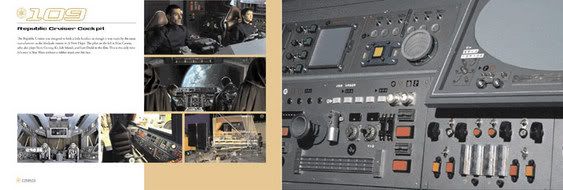
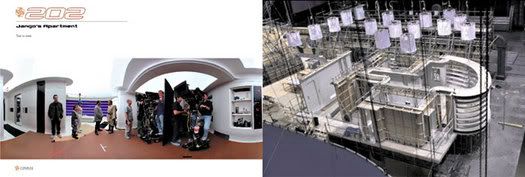

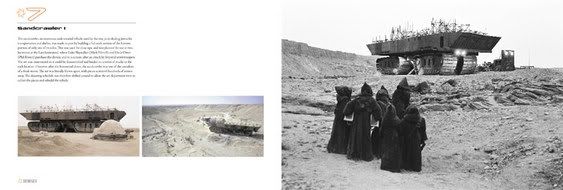
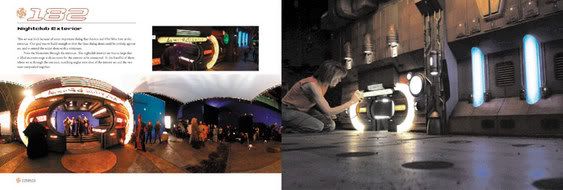
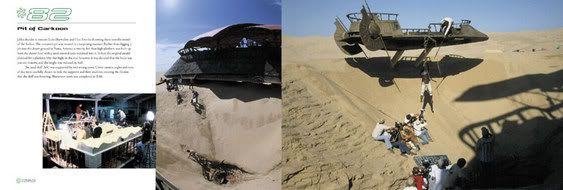
Scouring the Archives
After many fruitless searches through the digital database, Knoll discovered an untapped resource in the scores of unscanned negatives quietly stored in the archives.
"I found a big notebook that was just full of black and white negatives from The Empire Strikes Back and asked if there were any more. [Image Archivist] Scott Carter, who was kind of re-organizing the archive at the time, said nobody's ever interested in reproducing black and white, only color. So I said, man, I want these."
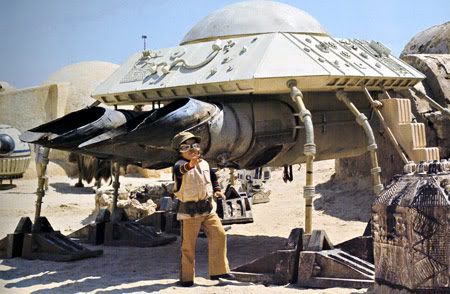
"The next day," continues Knoll, "Scott drove out to the archive building at the ranch and brought back this giant stack of contact sheets of all the black and whites. I think this book is one of the first ones to reproduce any of those."
From the stacks, Knoll was after a certain type of image for 365 Days, requiring him to weed through scores of unusable photos that were intended for general publicity.
"The majority of on-set pictures are usually from a still photographer that's standing right next to the taking camera, so the image looks like a frame out of the movie. But every once in a while there was a place where somebody took two steps back so you've got the familiar image that we've all seen a million times but it's embedded in this wider view where you see where the set ends. I love those kinds of pictures, and whenever I could find those, I'd put them in."
Supplementing Knoll's gathered images were the personal photos of ILM employees who were involved in the original production. Lorne Peterson's photo album became a source of some never-before-published imagery. Knoll was also able to ask first-generation ILMers like Paul Huston, Steve Gawley and Dennis Muren to explain what some of these images contained.
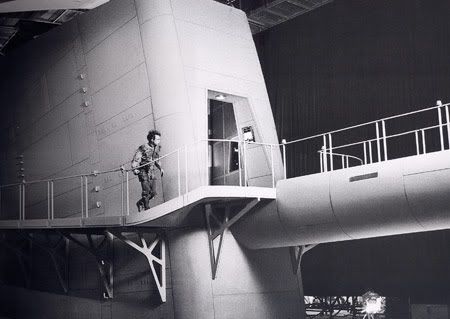
Knoll was also looking for images to corroborate the many on-set stories he'd been hearing about for years, but had never seen any photographic evidence to support them.
One of these was the Cloud City gantry duel shoot for Empire.
Knoll had long thought that the close-ups of Luke and Vader could not be composites.
"It looked like they were done in-camera, because there were no telltale artifacts of bluescreen compositing," explains Knoll. "What they did was actually super clever, and I found some good pictures to illustrate it. They made a couple of backings -- one as if you were looking straight across at the inside of the cylinder perspective, and another that had a tilted perspective. They used that one for the up-angles and rotated it 180 degrees for the down angles. I'd heard that something like that had been done, and here were some supporting images."
Other original trilogy surprises Knoll uncovered included pictures of Lando being lifted by a forklift to rise through the Falcon's top hatch in Empire, a dimmed down re-purposed Hoth hangar doubling as the interior of the space slug, and a scout walker head propped up on a piece of earth-moving equipment to "walk" through the Endor forest.
Because Knoll was researching his book during the final months of the Episode III production, he was able to ask Lucas directly about many of the mysteries suggested by the images.
"I would ask him one or two book questions, like, when did you shoot the scenes in Echo Base? And he'd say that it was like April, May, and June." With the sets not refrigerated, this was a bit of telling evidence. "Those guys wearing all those parkas," confides Knoll, "they were sweating like crazy." EDITOR'S NOTE: TO MAKE UP FOR ALMOST FREEZING TO DEATH IN NORWAY?

Like the original trilogy, the prequel trilogy had to be built from the ground up -- perhaps even more so, since the opulence of the days before the Empire encouraged far more exotic interiors and architecture than the pared-down "borrowed" look of the sequels.
"People just don't even think about the fact that all this stuff had to be made out of nothing," says Knoll. "You can't just go on location -- everything has to be constructed. How do you go about doing something with that kind of scale? There are some pretty straight forward methodologies that we used to do this, and we use different techniques for different reasons at different times. Hopefully, I've explained why we chose to do, say, this as a miniature, while it made sense to build that much of it as a set."
Bonus Multimedia
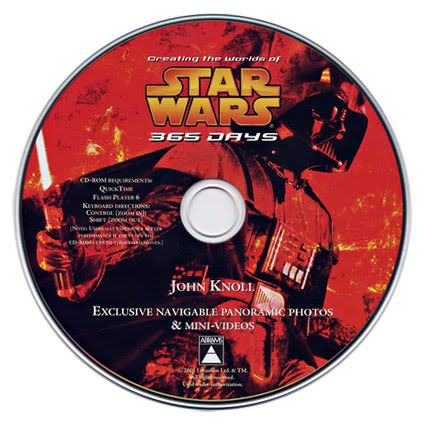
A great added feature of 365 Days is a CD-ROM which includes many of the sets depicted in the book from Episodes II and III, shot in the fully-immersive Knollvision format. Some of the panoramas on the disc were not published two-dimensionally in the book, making it a must-see bonus. EDITOR'S NOTE: OK, I WAS GETTING MORE AND MORE INTO THE IDEA OF THIS BOOK AS I'VE READ ALONG ABOUT THE DIFFERENT PICS AND DESCRIPTIONS. BUT THIS CD-ROM ALL BY ITSELF SOUNDS LIKE IT MAKES THE BOOK WORTH THE PRICE OF PURCHASE, HUH!?
Knoll also included some cool video shorts on the disc.
"One of the cameras I had with me on Episode II was one that can shoot short Quicktime movies, and I did a couple of things that are sort of amusing with it. I did one where I walked in the door of the Hotel Sidi Driss [Luke's Tatooine homestead], and I started at the front where you can see the door and the sign. As the camera's running, I walk in the front door past the receptionist's desk, turn right, go down this corridor, turn left down this corridor, and open up into C-3PO walking around inside the hotel. So there's a couple little things like that that you couldn't really capture just in stills that I put on the disc." EDITO'RS NOTE: SOLD. MUST BUY.
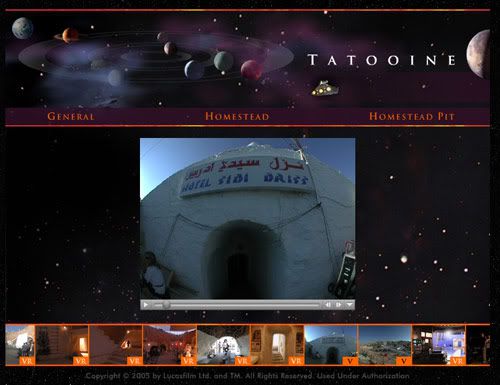
As a historical document, 365 Days bears witness to the perishable nature of movie sets, even those revered as having taken part in the Star Wars saga.
"There was one spread I ended up not doing because my wife objected. I found some pictures in the archive that I thought were pretty cool, and they were demolished sets. There were a couple that were between Empire and Jedi that were the full size Falcon exterior -- it was all smashed up and kind of piled in the junkyard in the back of EMI [Elstree Studios] along with other recognizable Star Wars set pieces in a heap. I thought, you know, this is a good way to talk about the very temporary nature of these sets that are torn apart as soon as they're done shooting them and lost forever. But Jennifer objected because she thought it was just too depressing to see the Falcon all busted up like that." EDITOR'S NOTE: TORN BETWEEN COMPLETE'ISM AND EMOTION HERE.
For the set creators who pain over every detail of their design and construction, a heavy dose of humility must come with the job. Of the hundreds of sets designed, manufactured, and shot for the Star Wars movies, not one physically survives today. What 365 Days offers is a glimpse into the craft and innovation of this art form which becomes ultimately intangible, but deeply felt by fans of the Star Wars saga.
"What I was trying to document was this whole 'how did they do it' thing," says Knoll. "The Star Wars pictures are classics, and I don't think I ever saw a document that comprehensively showed how a lot of this stuff is done."
For fans who are curious about the cryptic numbering system depicted at the bottom of each page, Senior Editor Jonathan Rinzler explains:
"They are an elaborate in-joke which originated with our former art director Iain Morris. Starting with Day One, they count down to "1138" which is on Day 365. The First Day is 00415370 (1138 x 365), then 00414232 (1138 x 364), etc. The zeroes are extra. Then with the index they convert to normal count down 004, 003, etc., and it's the computer in Luke's X-wing counting down to the exhaust port during the trench run on the Death Star, which is seen being blown up on the bookends. Crazy but true." EDITOR'S NOTE: DWEEBS WITH PUBLISHERS. SCARY.


0 Comments:
Post a Comment
<< Home